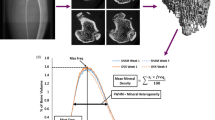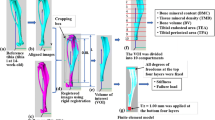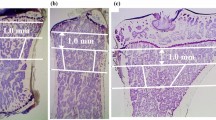Abstract
Osteoporosis is characterized by low bone mass and a deterioration of bone architecture and likely is influenced by genetic factors. The ovariectomized (OVX) mouse is well suited for osteoporosis research, as shown to date by cross-sectional studies. Here, we investigate longitudinal changes by in vivo micro-computed tomography (micro-CT) to examine the skeletal response to OVX and patterns of change in three inbred strains of mice. We address whether higher baseline bone mass among the strains of mice provides protection against bone loss and if there is a common base level of bone quantity despite genetic background after the effects of OVX have stabilized. Groups of mice (n = 7 or 8/group) from three inbred strains (C3H/HeJ, C57BL/6J, BALB/cByJ) were subjected to OVX or sham OVX surgery at 12 weeks of age. Weekly in vivo micro-CT scans were performed for 5 weeks at the proximal tibia (skipping week 4). Femurs were harvested after week 5 for analysis of the distal metaphysis and midshaft. The baseline bone architecture differed among the three inbred strains of mice, as did the longitudinal patterns of change due to OVX. At the end point, all three strains retained different bone architecture at the proximal tibia, distal femur, and femur midshaft. Rate of bone loss was correlated to amount of baseline bone volume (R = 0.82, P < 0.001). Morphological analysis indicated that trabecular bone loss due to OVX was manifested through reduced connectivity instead of overall thinning and that the quantity and rate of bone loss due to estrogen deficiency were in part genetically regulated.




Similar content being viewed by others
References
World Health Organization (1994) Assessment of fracture risk and its application to screening for postmenopausal osteoporosis. WHO, Geneva, pp 1–129
Melton LJ 3rd, Chrischilles EA, Cooper C, Lane AW, Riggs BL (1992) Perspective. How many women have osteoporosis? J Bone Miner Res 7:1005–1010
Ray NF, Chan JK, Thamer M, Melton LJ 3rd (1997) Medical expenditures for the treatment of osteoporotic fractures in the United States in 1995: report from the National Osteoporosis Foundation. J Bone Miner Res 12:24–35
Harris S, Dawson-Hughes B (1992) Rates of change in bone mineral density of the spine, heel, femoral neck and radius in healthy postmenopausal women. Bone Miner 17:87–95
Radspieler H, Dambacher MA, Kissling R, Neff M (2000) Is the amount of trabecular bone-loss dependent on bone mineral density? A study performed by three centres of osteoporosis using high resolution peripheral quantitative computed tomography. Eur J Med Res 5:32–39
Pouilles JM, Tremollieres F, Ribot C (1995) Effect of menopause on femoral and vertebral bone loss. J Bone Miner Res 10:1531–1536
Karasik D, Ginsburg E, Livshits G, Pavlovsky O, Kobyliansky E (2000) Evidence of major gene control of cortical bone loss in humans. Genet Epidemiol 19:410–421
Peacock M, Turner CH, Econs MJ, Foroud T (2002) Genetics of osteoporosis. Endocr Rev 23:303–326
Beamer WG, Donahue LR, Rosen CJ, Baylink DJ (1996) Genetic variability in adult bone density among inbred strains of mice. Bone 18:397–403
Turner CH, Hsieh YF, Müller R, Bouxsein ML, Baylink DJ, Rosen CJ, Grynpas MD, Donahue LR, Beamer WG (2000) Genetic regulation of cortical and trabecular bone strength and microstructure in inbred strains of mice. J Bone Miner Res 15:1126–1131
Turner CH, Hsieh YF, Müller R, Bouxsein ML, Rosen CJ, McCrann ME, Donahue LR, Beamer WG (2001) Variation in bone biomechanical properties, microstructure, and density in BXH recombinant inbred mice. J Bone Miner Res 16:206–213
Alexander JM, Bab I, Fish S, Müller R, Uchiyama T, Gronowicz G, Nahounou M, Zhao Q, White DW, Chorev M, Gazit D, Rosenblatt M (2001) Human parathyroid hormone 1–34 reverses bone loss in ovariectomized mice. J Bone Miner Res 16:1665–1673
Bouxsein ML, Myers KS, Shultz KL, Donahue LR, Rosen CJ, Beamer WG (2005) Ovariectomy-induced bone loss varies among inbred strains of mice. J Bone Miner Res 20:1085–1092
Iwaniec UT, Yuan D, Power RA, Wronski TJ (2006) Strain-dependent variations in the response of cancellous bone to ovariectomy in mice. J Bone Miner Res 21:1068–1074
Boyd SK, Davison P, Müller R, Gasser JA (2006) Monitoring individual morphological changes over time in ovariectomized rats by in vivo micro-computed tomography. Bone 39:854–862
Klinck RJ, Campbell GM, Boyd SK (2008) Radiation effects on bone architecture in mice and rats resulting from in vivo micro-computed tomography scanning. Med Eng Phys (in press). doi:10.1016/j.medengphy.2007.11.004
Brouwers JE, van Rietbergen B, Huiskes R (2007) No effects of in vivo micro-CT radiation on structural parameters and bone marrow cells in proximal tibia of Wistar rats detected after eight weekly scans. J Orthop Res 25:1325–1332
Buie HR, Campbell GM, Klinck RJ, MacNeil JA, Boyd SK (2007) Automatic segmentation based on a dual threshold technique for in vivo micro-CT bone analysis. Bone 41:505–515
Brouwers JE, van Rietbergen B, Huiskes R (2007) No effects of in vivo micro-CT radiation on structural parameters and bone marrow cells in proximal tibia of Wistar rats detected after eight weekly scans. J Orthop Res 25:1325–1332
Halloran BP, Ferguson VL, Simske SJ, Burghardt A, Venton LL, Majumdar S (2002) Changes in bone structure and mass with advancing age in the male C57BL/6J mouse. J Bone Miner Res 17:1044–1050
Glatt V, Canalis E, Stadmeyer L, Bouxsein ML (2007) Age-related changes in trabecular architecture differ in female and male C57BL/6J mice. J Bone Miner Res 22:1197–1207
David V, Laroche N, Boudignon B, Lafage-Proust MH, Alexandre C, Rüegsegger P, Vico L (2003) Noninvasive in vivo monitoring of bone architecture alterations in hindlimb-unloaded female rats using novel three-dimensional microcomputed tomography. J Bone Miner Res 18:1622–1631
Sims NA, Morris HA, Moore RJ, Durbridge TC (1996) Increased bone resorption precedes increased bone formation in the ovariectomized rat. Calcif Tissue Int 59:121–127
Kalu DN, Liu CC, Hardin RR, Hollis BW (1989) The aged rat model of ovarian hormone deficiency bone loss. Endocrinology 124:7–16
Wronski TJ, Cintron M, Dann LM (1988) Temporal relationship between bone loss and increased bone turnover in ovariectomized rats. Calcif Tissue Int 43:179–183
Honda A, Umemura Y, Nagasawa S (2001) Effect of high-impact and low-repetition training on bones in ovariectomized rats. J Bone Miner Res 16:1688–1693
Honda A, Sogo N, Nagasawa S, Shimizu T, Umemura Y (2003) High-impact exercise strengthens bone in osteopenic ovariectomized rats with the same outcome as sham rats. J Appl Physiol 95:1032–1037
Boyd SK, Moser S, Kuhn M, Klinck RJ, Krauze PL, Müller R, Gasser JA (2006) Evaluation of three-dimensional image registration methodologies for in vivo micro-computed tomography. Ann Biomed Eng 34:1587–1599
Acknowledgements
This work was supported by grants from the Natural Sciences and Engineering Research Council of Canada, the Canadian Institutes of Health Research, the Canada Foundation for Innovation, the Alberta Heritage Foundation for Medical Research, and the Alberta Ingenuity Fund.
Author information
Authors and Affiliations
Corresponding author
Rights and permissions
About this article
Cite this article
Klinck, J., Boyd, S.K. The Magnitude and Rate of Bone Loss in Ovariectomized Mice Differs Among Inbred Strains as Determined by Longitudinal In vivo Micro-Computed Tomography. Calcif Tissue Int 83, 70–79 (2008). https://doi.org/10.1007/s00223-008-9150-5
Received:
Accepted:
Published:
Issue Date:
DOI: https://doi.org/10.1007/s00223-008-9150-5




